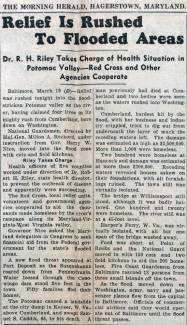Collection Name
About
THE MORNING HERALD, HAGERSTOWN, MARYLAND.
Relief Is Rushed To Flooded Areas
Dr. R. H. Riley Takes Charge of Health Situation in Potomac Valley-—Red Cross and Other Agencies Cooperate
Baltimore, March, 19 -Relief was rushed tonight into the floodstricken Potomac valley as the river, having claimed four lives in its mighty rush from Cumberland, bore down on Washington.
National Guardsmen, directed by Maj.-Gen. Milton A. Reckord, under instruction from Gov. Harry W. Nice, moved into the flood zone with cots and field kitchens. Riley Takes Charge
Health officers of five counties worked under direction of Dr. Robert H. Riley, state health director, to prevent the outbreak of disease and apparently were succeeding.
The Red Cross, local relief units, volunteers and government agencies cooperated to aid the thousands made homeless by the river's rampage along its Maryland-Virginia-West Virginia valley.
Governor Nice asked the Maryland delegation in Congress to seek financial aid from the Federal government for the state's flooded areas.
A new flood threat appeared at Port Deposit as the Susquehanna roared down from Pennsylvania. Water loosed through the Conowingo dam stood five feet in the town. Fifty families fled their homes.
The Potomac caused a landslide at the city dump in Keyser, W. Va., above Cumberland, and swept Samuel S. Caddik, 65, to his death. A man previously had died at Cumberland and two bodies were seen as the waters rushed into Washington.
Cumberland, hardest hit by the flood, with her business and industry crippled, tried to dig out from underneath the layer of muck the receding waters left. The damage was estimated as high as $3,500,000. More than 1,000 were homeless.
Two hundred were homeless at Hancock and damage was estimated at more than $200,000. Receding waters revealed houses askew on their foundations, with all furnishings ruined. The town still was virtually isolated.
The bridge at Williamsport still stood, although it was badly battered. One hundred and twenty were homeless. The river still was at a 45-foot level.
Harper's Ferry, W. Va., was virtually isolated, with all but one span of the bridge washed away.
Food was short at Point of Rocks and the National Guard moved in with 150 cots and two field kitchens to aid the 200 homeless. Five Coast Guardsmen from Baltimore rescued 18 persons from three small islands off the town.
As the flood moved down on Washington, army, navy and passenger planes flew from the capital to Baltimore. Officials of commercial airlines said they would operate out of Baltimore until the flood threat passes.
